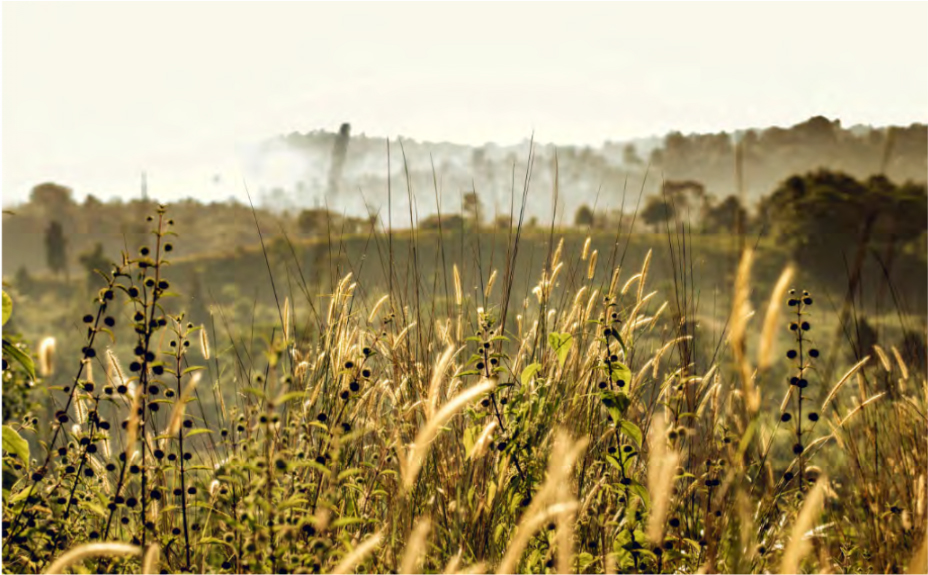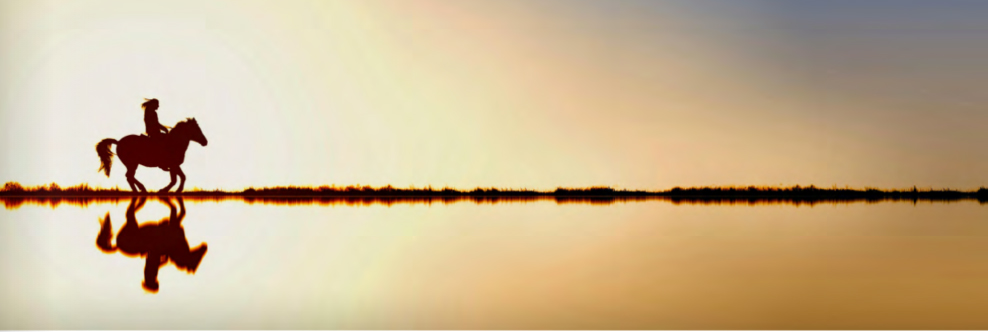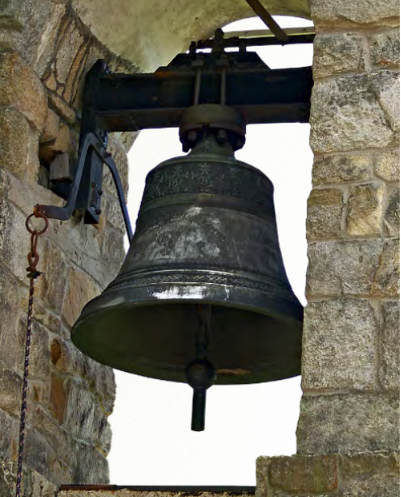A Fine Time to Be Embodied
Susan Curtiss
When I reflect on the experience of embodiment, I find I want to invite you, dear reader, to be open to your physical senses, present in the moment to the world around you with little contraction, and grounded in your body. Given the social, political and environmental chaos that we see in so many places, like the wars in Gaza and Sudan or the wildfires in Los Angeles and Canada, you may be feeling it’s the last thing you want to do. Escaping to the higher realms as soon as possible and exploring the more remote planes of consciousness can feel like the more desirable endeavor! Of course those of you who have already brought the soul forward to rule your nature need read no further. My invitation is for the rest of us who are committed to a yogic path and still are works in progress aspiring, remembering, and offering ourselves in surrender to the Divine who dwells within us. We are challenged to purify and move beyond the ego, embracing our identity with all the living world. Despite the outer upheavals we see everywhere, this part of the journey seems to me to be more possible and accessible now. The preparation we must undertake to be ready for the coming human transformation is awaiting our commitment to be in our lives, fully embodied on Planet Earth.
How have I arrived at this conclusion? Looking back I can see the circumstances and even where and when my desire to live in the physical body, aware of its spiritual dimension, arose. At that time the conditions for a “new” perception of what it is like to be in the body were extremely favorable. I was a teenager riding horseback with a friend. It was late afternoon on a warm summer day. The sky was cobalt blue and cloudless, and a light breeze was bringing us the scent of mown grass and wildflowers and the sweat of the horses. We were galloping down an open meadow and my legs were gripping the saddle. I could feel the movement of the horse as it strode along and I enjoyed its power and aliveness. Suddenly the Angelus[1] began to ring from the Carmelite monastery sequestered on the hillside overlooking the field. Its ancient call to prayer pervaded the meadow.

With that sacred sound something inexplicable happened: All my senses merged and I felt one with everything. I merged with all that I and my surroundings could encompass—the horse, the meadow, the sky, the breeze, the sunlight, the sound of the bell. There was no separation. A feeling of intense joy enveloped me. The experience was short-lived—maybe five or so strides of the horse. But the material world had opened and revealed more of its truth to me. I was transported into something I could not name or explain.
Prior to this “moment” I was disappointed to find myself embodied. I had been longing to experience God in the rites of the Episcopal Church I devoutly attended. My heart opened the most when singing the traditional hymns. But the rites of communion and confirmation were not life altering experiences for me, though I longed for them to be so. I had concluded God was to be known in the afterlife or the ethers but certainly not in the saddle! And yet here I was out in nature with all its sensuousness doing what I loved to do—playing with this large, beautiful, and powerful animal! My piety was dashed forever! The Divine had somehow appeared and overtaken me. From then on I knew spirit and nature dwelled together. I wanted to live united with both.
I did not discover Sri Aurobindo and the Mother until I was forty. In the intervening years I looked everywhere in the material world for the presence of spirit. I was not disappointed. I was teased, invited, and led by many experiences in the body, without a body, and with the body dissolving into light. In retrospect I was no doubt drawn here and there by the Mother through music, while gardening and working with animals, engaging in spiritual practices , and sharing hundreds of healing journeys with my psychotherapy clients. Eventually Sri Aurobindo’s writing and the Mother’s journey in the body left me no doubt. Matter holds the Divine within it. And to be in the Divine in oneself and find it everywhere one must be present in the body in the moment without constriction. That brings a powerful awakening and spirit can descend into matter. Looking back I can see that on that horse on that day I was in just that “place,” given over to the aliveness of staying in the saddle and being fully on the horse moment to moment!

This leads me to two encouraging developments for our work in the body that have emerged as the transformative consciousness[2] descends and spreads its force. The first pertains to the aspect of the yoga concerned with releasing the contractions we can develop from our ego’s response to the world around us, which prevent us from relating to our lived mental and emotional reality. Psychological understanding of this process has increased significantly in the last five decades. To cleanse ourselves and fully inhabit the body without constrictions caused by the ego’s efforts at survival is no easy task. But we finally understand the process more clearly as we have elucidated the role of trauma.
By trauma we mean experiences that overwhelm our capacity to process them and retain our sense of identity. We know that traumatic events from our ancestors’ lives can affect successive generations, and we can even register the overwhelming circumstances our parents may be having while we are in the womb. We are designed psychologically to defend ourselves against experiences that we cannot metabolize. The fight, flight, and freeze responses that were seen as pathological are now understood as necessary survival mechanisms; and we have good methods to work with them. Finding our blockages that cause our constrictions can be a frightening, wearying, and disheartening process. All of us react and pull back from our life experiences in one way or another. Time-honored spiritual practices have evolved to deal with this challenge in many ways.
A truly exciting form of psychological understanding has been articulated that includes knowledge of the planes of consciousness that Sri Aurobindo explored and shared so masterfully. The work of Soumitra Basu and Michael Miovic in their book Consciousness-Based Psychology[3] paves the way for a profound understanding of the various occult aspects of consciousness that affect our behavior. The reality of hostile forces and possession states originating beyond the individual’s action, conscious, or unconscious are legitimized and their origins in non-ordinary levels of consciousness are clarified. Opening the gates to this level of understanding enlarges the scope of diagnosis and treatment for individuals undergoing these realities in a myriad of ways and legitimizes the role of the therapist’s intuition. The assistance of those who are adept at perceiving the play of non-ordinary levels of consciousness in human behavior can be utilized.
Reacting and pulling back from forces that may be occult and not possible to metabolize is so important to acknowledge and not label as mental illness. In my view accepting the reality of inner dimensions and uniting this perspective with the best aspects of our understanding of human development can produce greater compassion and patience for our tendencies to pull away and close off to our experiences.
That brings me to the second encouraging development for our work of embodiment that opens us to all life and the Earth itself. Imagine that you have persisted in clearing your physical body awareness, and very little impedes your “contact” with the living world around you. How do you become “one” with it? Ultimately as we dwell more and more in the inner being and our soul comes forward, our consecration to the Divine determines our path. But what can we do and explore in the meantime as we progress in conscious awakening? Western science has studied matter in its most subtle dimensions and even determined that the heart is more powerful than the mind in creating awareness and action.[4]

But we are still caught in a separative mode of perception. I would ordinarily not feel myself “one” with a horse or the meadow or the sound of a bell! I would be the subject and these perceptions objects and as such existing outside and separate from “myself.” Even though we have several models of the energetic fields we are immersed in, our tendency remains to see what we perceive with our senses as an object, something to be analyzed, taken apart, and utilized.
Fortunately other cultures have evolved other ways of perceiving and relating to our Earth which have allowed them to live in balance and harmony with the natural world. Exploring their mind-set brings us into the possibility of experiencing more of the sense of oneness that I was introduced to in that moment on horseback. We are now able to turn to the wisdom teachings and practices of indigenous and aboriginal cultures. The indigenous shamans of the Andes and many other areas of the planet are coming forward and sharing their wisdom and their practices.[5] My explorations and experiences of their practices and rituals have taught me that they too seek to awaken and live from the innermost heart. They also see this as a time of great upheaval and transition.
But their starting point is a profound sense of kinship. Respect, gratitude, reciprocity, and sustainability are keys to their relationship with the being of Mother Earth and all her inhabitants. Their action starts with contact with spirit and evolves from there. Everything is living and Spirit dwells within it. They cultivate connection with what Sri Aurobindo would call the subtle physical and they turn to Spirit in many ways for guidance. One could say that through their openness to Spirit and kinship they already practice a form of knowledge by identity.
But another way to look at their creation of the sense of oneness is to consider their way of conducting spiritual practice. The shamans “journey” and it can be said that they are masters of the wave aspect of the quantum field rather than the particle aspect. Spiritual practice starts with the cultivation of all in a moment of oneness. Time, not space, is the critical orientation. The possibility of learning this manner of spiritual awareness is available to us, ironically, through technology as well as in person. Indigenous shamans from around the globe are sharing their wisdom and rituals and practices. Our task is to open to this wisdom without appropriating their traditional ways. As one invitation to join in the offerings from the Shaman’s Directory states:
For generations, First Peoples, Indigenous and Traditional Nations have lived by the “original instructions,” the natural laws of reciprocity, respect, and responsibility that sustain life. These teachings are not relics of the past but living knowledge systems that continue to thrive in cultures around the world. They remind us that everything is interconnected, that the land itself is a teacher, and that wisdom is not something to be owned, but something to be carried with humility and shared with integrity.[6]
To someone on an adventure to become available for a transformation of the human body and consciousness, I add an awareness of authentic indigenous lineage-based teachings to the Mother’s teaching. She was clear about the role of sport and athletics and physical mastery to make the body plastic and receptive to a change in cellular consciousness. And as the transformative consciousness descends we also find Western teachers who can open avenues of exploration and experience.
We can learn from people who can teach us to open and communicate with living beings other than our human fellows. We can practice communication with animals[7] and plants[8] as did the Mother. Our shamanic wisdom keepers have shared their knowledge of the gifts of plant allies in expanding our consciousness, and it is now entering mainstream medical and psychological practice. And we have an exquisite philosophy of sensuous contact with the non-human world of animate and inanimate beings brought forward by David Abram.[9] John Milton has developed a process of awakening within the Natural world that is an amalgamation of the teachings of many spiritual traditions of which he is an adept.[10] He has developed a process that teaches us to awaken to our innermost consciousness through spending time in wild nature itself. In his “sacred passage” program “source” awareness is cultivated through extended time spent alone in Nature in isolated wild places. A form of vision quest is used to deepen the experience. Awakening can result for the practitioner.
So I invite you, dear reader, to take heart and body and explore where you are constricted and open to the Spirit in all the life around you. It is a way of opening to the Mother’s work in you. The Western and indigenous ways of seeing and being in the world are coming together. This is a huge step forward toward the evolution of the new “human species.” Open to the life around you and communicate with it openly and feel the joy of kinship and mutual sharing. May you embrace the physical consciousness and open to its gifts as you prepare the way for Spirit to enter.
NOTES
[1]. The bell tolling the Angelus is a call to prayer in the Roman Catholic tradition. It commemorates the incarnation of Christ at the Annunciation, the moment when the Angel Gabriel announced God’s invitation for Mary to be the mother of the Messiah. It is prayed three time a day: 6 a.m., noon, and 6 p.m.
[2]. Sri Aurobindo has called this evolutionary development of consciousness gradually becoming available to humankind the supramental consciousness. As it manifests it will bring about a change in the human physical and cellular formation. Through this development humankind will become fore able to embody and realize planes of consciousness closer to the Divine.
[3]. Soumitra Basu, M.D. and Michael Miovic, M.D., Consciousness-Based Psychology: Sri Aurobindo’s Vision of Yoga, Health and Transpersonal Growth (Kolkata, India: Institute of Integral Yoga Psychology, 2022).
[4]. The Heart Mind Institute’s research has revealed that the impulse that leads to action arises in the heart prior to the mind: https://www.heartmind.co/?r_done=1
[5]. Excellent resources for the offerings of indigenous wisdom teachers are to be found at: https://shamansdirectory.com/ and https://shamanportal.org/ and The Four Winds Society: https://thefourwinds.com/
[6]. This statement comes from an email notice sent out on April 1, 2025, announcing the coming offerings from Shaman’s Directory. It is no longer on the internet at their website. It captures the need for respect from those wanting to learn from traditional indigenous wisdom. This wisdom is not to be taken out of context without awareness of its origins and aliveness today. For more information go to https://shamansdirectory.com.
[7]. Dawn Allen is a leading teacher of animal communication and an artist. Connect with her at: https://www.dawnallen.org/
[8]. Pam Montgomery, Plant Spirit Healing: A Guide to Working with Plant Consciousness (Rochester, Vermont: Bear and Company, 2008); and Stephen Harrod Buhner, Plant Intelligence and the Imaginal Realm (Rochester, Vermont: Bear and Company, 2014).
[9]. David Abram, The Spell of the Sensuous: Perception and Language in a More-Than-Human World (New York: Vintage Books, 2017); and Becoming Animal: an Earthly Cosmology (New York: Vintage Books, 2010). See also https://www.davidabram.org.
[10]. John P. Milton, Sky Above Earth Below: Spiritual Practice in Nature (Boulder, Colorado: Sentient Publications, LLC, 2006).

